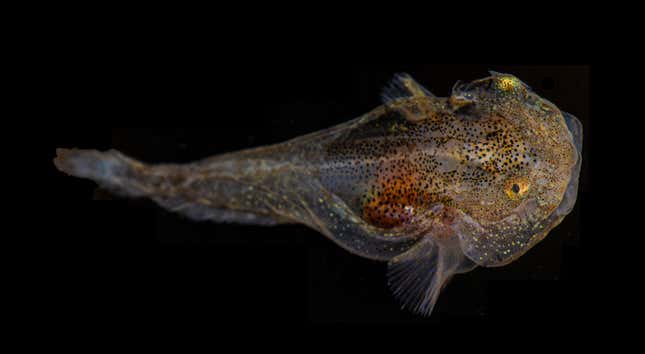
The deep sea is filled with creatures adapted to intense environments, and new research describes how biofluorescent snailfish near Greenland use antifreeze proteins to keep themselves alive in frigid waters.
Researchers from the American Museum of Natural History and the City University of New York wanted to know how snailfish in an iceberg habitat located off the coast of Eastern Greenland survive in water around 28.4 degrees Fahrenheit (-2 degrees Celsius). They sequenced the RNA of a juvenile Liparis gibbus—more commonly known as the variegated snailfish—and found that the fish rely on a high level of special proteins to limit the formation of ice crystals inside their bodies. Their work is published in Evolutionary Bioinformatics.
“There is a wide diversity of mechanisms that different animals have evolved to withstand extreme cold,” said study author David Gruber in an email to Gizmodo. “Antifreeze proteins prevent large ice crystals from forming in their bodies. Other strategies, like cytoprotectants, help minimize cell shrinkage, and other adaptations help maintain membrane structure.”
The snailfish generate the proteins in the liver, from which they are dispersed into the blood. The antifreeze proteins do not completely prevent the formation of ice crystals, but instead limit their growth to “manageable sizes,” as described in the paper.
Gruber, a research associate at the American Museum of Natural History and a professor at CUNY, along with co-author John Sparks observed snailfish glowing green and red during an August 2019 expedition. This was the first documentation of biofluorescence in Arctic fish.
“When we discovered that the snailfish was biofluorescent, we sequenced its entire transcriptome to look for the gene responsible for its fluorescent protein,” Gruber said. “While we did not locate this gene, we noticed that some of the most highly expressed genes were related to antifreeze proteins.”
Since these fish are optimized for freezing waters, the researchers are concerned about what will happen to the snailfish as ocean temperatures warm. While the snailfish can survive in warmer waters, those warmer waters will bring biodiversity into higher latitudes—potentially threatening their role in the food chain.